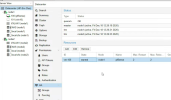Hi,
I have two Proxmox server and want to join them to a cluster.
Here I have some questions:
1)
Does it matter which server is the master and which one the slave?
2)
I read that the slave server must be empty from virtual machines before joining to the master server.
3)
What happens when one of the servers breaks down, is the other server still running without problems (except when the storage of the virtual machines were stored on the server, which breaks away).
4)
I made the empty server (newer than the other server) to the master server - how can I remove this cluster to make the other server, which containes virtual machines, to the master server?
I only clicked to "Create Cluster" but this commands does not remove the master functionality.
VMware's concept of joining more VMware servers is better than Proxmox - there servers can be merged, although they contains virtual machines. Also the renaming of virtual machines is possible, in Proxmox it seems not to be possible.
I have two Proxmox server and want to join them to a cluster.
Here I have some questions:
1)
Does it matter which server is the master and which one the slave?
2)
I read that the slave server must be empty from virtual machines before joining to the master server.
3)
What happens when one of the servers breaks down, is the other server still running without problems (except when the storage of the virtual machines were stored on the server, which breaks away).
4)
I made the empty server (newer than the other server) to the master server - how can I remove this cluster to make the other server, which containes virtual machines, to the master server?
I only clicked to "Create Cluster" but this commands does not remove the master functionality.
Code:
systemctl stop pve-cluster.service
/etc/pve/corosync/corosync.confVMware's concept of joining more VMware servers is better than Proxmox - there servers can be merged, although they contains virtual machines. Also the renaming of virtual machines is possible, in Proxmox it seems not to be possible.
Last edited:


